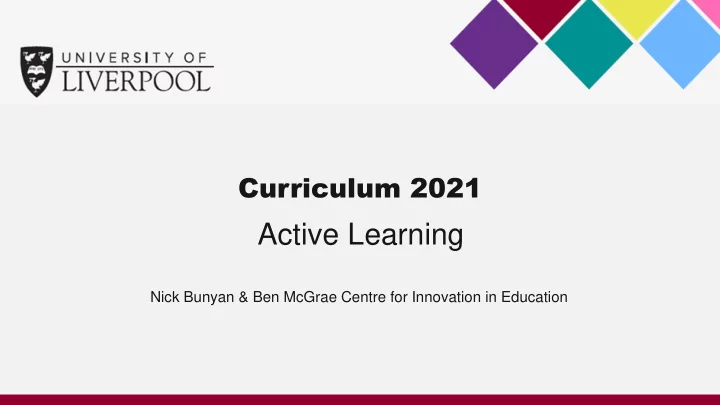

Curriculum 2021 Active Learning Nick Bunyan & Ben McGrae Centre for Innovation in Education
Introduction to the workshops Part 1: one hour overview to the Active Learning Hallmark in Curriculum 2021. Part 2: Introduction to the Active Learning network
Workshop learning outcomes 1. Conceptualise the active learning hallmark in your learning and teaching context. 2. Identify and explore existing examples of your application of active learning. 3. Introduce an approach to developing active learning. 4. Investigate and identify potential new applications of active learning to enhance your learning and teaching and you associated support requirements.
Activity #1 What questions do you have about active learning in the context of Curriculum 2021? Go to PollEv.com/benmcgrae373 or text BENMCGRAE373 to 020 3322 5822
Active Learning (AL) in Curriculum 2021
An overview to active learning Improving student learning in 'traditional' forms of learning & teaching e.g. lectures
An overview to active learning Greater application, where appropriate, of active forms for learning & teaching e.g. team based learning
An overview to active learning 2 important aspects: 1. Appropriate student skill development: learning, research, employability. 2. Increasing application of formative feedback : self, peer, tutor.
Activity #2 What active learning do you currently use in your learning and teaching? Go to PollEv.com/benmcgrae373 or text BENMCGRAE373 to 020 3322 5822
Active learning resources 1. Curriculum 2021 booklet – overview to all the Hallmarks, Attributes and Principles. 2. Curriculum 2021 case studies – examples of effective practice for each Hallmark and Attributes (ongoing development). 3. Programme level self-evaluation questions (P-SEQ) - used by programme teams to support the review of programmes. Important: P-SEQ is for programme teams to reflect and discuss how to engage with Curriculum 2021 and not a compliance document. www.liverpool.ac.uk/cie
Activity #3 Reflect on you application of active learning to an area of your learning and teaching: 1. Learning outcomes: are module intended learning outcomes written in student learning terms? 2. Application of active learning: how are you, or how could you support the greater use of active learning? 3. Learning skills: do students have the learning skills to engage with active forms of learning used? 4. Formative feedback: how effectively do you, how could you further enhance student learning with formative feedback? 5. Communication: how well do you, could you communicate the purpose of any active learning & formative feedback that you use?
Workshop feedback Please give feedback on this workshop using the provided form.
Curriculum 2021 Active learning network
Curriculum 2021 Active learning network Purpose: • Share best practice & expertise. • Innovate and solve problems collaboratively. • Collaborate on ideas and projects. • Invite in external experts.
Curriculum 2021 Active learning network Proposed structure: • Network for each of the 3 hallmarks and 3 attributes. • Open to all staff to join single or all networks. • CIE to facilitate, but open to staff to suggest areas of focus and discussion. • One physical meeting per semester. • Digital technologies to support – initially email Listserv. • Annual showcase event.
Curriculum 2021 Active learning network Post your comments to the following online Padlet site: https://padlet.com/livunicie/cbaveq4o8n5q
An approach to developing active learning Focuses on what students are doing to support their learning: 1. Develops from programme/ module intended learning outcomes. 2. Integrates formative assessment & feedback.
Intended learning outcomes
Intended learning outcomes
Intended learning outcomes: Bloom's taxonomy Bloom’s taxonomy Evaluation 6 Synthesis 5 Analysis 4 Application 3 Comprehension 2 Knowledge 1
Example intended learning outcomes
Recommend
More recommend